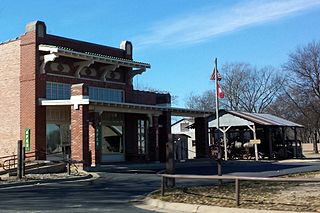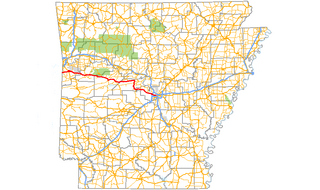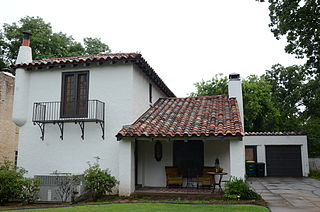
Pulaski County is located in the U.S. state of Arkansas with a population of 391,911, making it the most populous county in Arkansas. Its county seat is Little Rock, which is also Arkansas's capital and largest city. Pulaski County is Arkansas's fifth county, formed on December 15, 1818, alongside Clark and Hempstead Counties. The county is named for Casimir Pulaski, a Polish volunteer who saved George Washington's life during the American Revolutionary War. Pulaski County is included in the Little Rock–North Little Rock–Conway, AR Metropolitan Statistical Area which had 731,612 people in the 2015 census estimates. The Little Rock, North Little Rock Combined Statistical Area had 904,469 people in the 2015 census estimates.

Ashley County is a rural South Arkansas county with a culture, economy, and history based on timber and agriculture. Created as Arkansas's 52nd county on November 30, 1848, Ashley County has seven incorporated municipalities, including Hamburg, the county seat and Crossett, the most populous city. The county is also the site of numerous unincorporated communities and ghost towns. The county is named for Chester Ashley, a prominent lawyer in the Arkansas Territory and U.S. senator from the state from 1844 to 1848.

Scott is an unincorporated community and census-designated place (CDP) in Lonoke and Pulaski counties in the central part of the U.S. state of Arkansas. The population was 72 at the 2010 census. It is part of the Little Rock–North Little Rock–Conway Metropolitan Statistical Area.

Arkansas Highway 10 is an east–west state highway in West Arkansas. The route runs 135.41 miles (217.92 km) from Oklahoma State Highway 120 near Hackett east to Interstate 30 in Little Rock, the state's capitol. The highway serves both the Fort Smith metropolitan area and the Little Rock – North Little Rock – Conway metropolitan area.

Hillcrest Historic District is a historic neighborhood in Little Rock, Arkansas that was listed on the National Register of Historic Places on December 18, 1990. It is often referred to as Hillcrest by the people who live there, although the district's boundaries actually encompass several neighborhood additions that were once part of the incorporated town of Pulaski Heights. The town of Pulaski Heights was annexed to the city of Little Rock in 1916. The Hillcrest Residents Association uses the tagline "Heart of Little Rock" because the area is located almost directly in the center of the city and was the first street car suburb in Little Rock and among the first of neighborhoods in Arkansas.

Arkansas Highway 365 is a north–south state highway in Central Arkansas. The route of 69.31 miles (111.54 km) runs from US 65B/US 79B in Pine Bluff north through Little Rock to US 65B/AR 60 in Conway. The route is a redesignation of former U.S. Route 65, which has since been rerouted onto various Interstate highways through the area. Portions of Highway 365 in Jefferson County are former alignments of the Dollarway Road, which was the longest paved concrete road upon completion in 1913.

This is a list of the National Register of Historic Places listings in Pulaski County, Arkansas.

The Land's End Plantation, also known as James Robert Alexander House, is a historic plantation at 1 Land's End Land in rural southeastern Pulaski County, Arkansas, off Arkansas Highway 161 south of Scott. It is a 5,000-acre (2,000 ha) working plantation, located on the banks of the Arkansas River. The main plantation complex includes a 1925 Tudor Revival house, designed by John Parks Almand, and more than 20 outbuildings. AR 161, which passes close to the main house, is lined by pecan trees planted about 1900 by James Robert Alexander, the plantation owner.

The Wilkinson-Martin House, also known as the Sims House, is a historic Federal style house at 954 North 1st Street in Pulaski, Tennessee. The house was built between 1830 and 1835. It is the oldest Federal style house and one of the oldest houses of any style surviving in Pulaski.

Walnut Grove Methodist Church is a historic church in rural western Pulaski County, Arkansas. It is located southwest of Little Rock, on the east side of Walnut Grove Road between County Roads 38 and 31. It is a modest single-story wood-frame structure, with a gabled roof, rough-cut clapboard siding, and vernacular Greek Revival detailing. Its interior is finished with wooden planking, and it retains original period pews of similarly simple construction. Built in 1885, it is the oldest church in Pulaski County.

The Frenchman's Mountain Methodist Episcopal Church—South and Cemetery is a historic church in Cato, Arkansas. Located at the junction of Cato, Frenchman Mountain, and Camp Joseph Robinson Roads, it is a single-story wood-frame structure, built in 1880 as a two-story building to house both religious services and the local Masonic lodge. The upper story, housing the lodge facilities, was removed in 1945. The congregation was organized in 1872 in Cato, the oldest community in northern Pulaski County. The church declined after most of the land in the area was taken to establish Camp Joseph T. Robinson, with the church now enclaved within its bounds.

The Doe Branch Post Office is a historic house and post office in rural western Pulaski County, Arkansas. Located on the north side of Kanis Road, just west of its junction with Golden Eagle Drive, it is an L-shaped single-story structure built in a sequence of steps. The oldest portion is a single-pen board-and-batten structure, built in 1890 by Noah Richards. To this were added a clapboard addition to the side, a porch to the rear, and a kitchen, also to the rear, giving the building its present L shape. The building is one of the oldest in the Ferndale area, which was originally known as Doe Run, and was occupied by two generations of the Richards family.

The Duffy House is a historic house at 124 East "A" Street in North Little Rock, Arkansas. It is a two-story stuccoed structure with a tile roof in the Spanish Colonial style, with a single-story addition to the west, and a garage to the southwest, with a small attached maid's quarters. The house was built in 1929 by Justin Stewart as part of a large subdivision. Due to the effects of the Great Depression, it remained unsold for several years, and typifies the houses built in the subdivision before the 1929 stock market crash.

The Harris House is a historic house in rural southeastern Pulaski County, Arkansas. Built in 1856, it is one of the oldest houses in central Arkansas. It is a modest 1 1⁄2-story wood-frame structure, built out of local hand-hewn cypress and handmade bricks. It has an open porch extending across a five-bay front facade, with gable dormers projecting from the roof above. The entrance is flanked by sidelight windows and topped by a transom. The wood used in construction is virgin cypress, some of it planed to a width of 16 inches (41 cm). The house was built on land acquired by Robert Harris in 1853, part of which was granted by President John Quincy Adams. The land was still in the hands of Harris' descendants in 1976, when it was listed on the National Register of Historic Places.

The Howell-Garner-Monfee House is a historic house at 300 West Fourth Street in North Little Rock, Arkansas. It is a 2-1/2 story brick structure, with a wide gable roof pierced by gabled dormers. A single-story porch wraps around the east and north sides, with brick posts and a dentil course in the eave. The main entrance is flanked by pilasters and sidelights, with a distinctive transom window that has semi-circular sections joined by a straight section. Built in 1906, it is one of the best-preserved examples of housing built in the city's most fashionable neighborhood of that period.

The Palarm Bayou Pioneer Cemetery is a historic cemetery in a rural-suburban area of northern Pulaski County, Arkansas. It is located northwest of Maumelle, between the Arkansas River Trail and Palarm Creek, on a rise that is now part of the gated Mountain Crest residential subdivision. The small cemetery, with just ten marked graves, stands at the top of a rise north of Mt. Pilgrim Baptist Church. Nine of the graves are surrounded by a low stone wall, while one is set outside that enclosure, surrounded by a wrought iron fence. The oldest of the marked graves is that of Daniel Wilson, who died in 1837. The cemetery is probably one of the county's oldest.

The Pulaski County Courthouse is located at 405 West Markham Street in downtown Little Rock, Arkansas, the state capital and the county seat of Pulaski County. It is set among a number of other state and city government buildings, on a city block bounded by West Markham, Spring, West 2nd, and South Broadway Streets, with a county park occupying the western portion of the block. The courthouse has two portions: an elaborate Romanesque edifice built of stone and brick in 1887–89 to a design by Max A. Orlopp, and a large four-story Beaux Arts annex designed by George Mann and added in 1913–14. The annex is acknowledged as one of Mann's most successful commissions.

The Rapillard House is a historic house at 123 West 7th Street in North Little Rock, Arkansas. It is a two-story structure, with a steeply pitched gable roof, and an exterior of brick and stucco. A two-story cross-gabled section flanks the entrance on the right, while the roof above the center and left bays is broken by gabled dormers. A porch extends across the left two bays. The house was built in 1927, and is a good local example of vernacular English Revival architecture.

The Dr. Charles H. Kennedy House is a historic house at 6 Edenwood Lane in North Little Rock, Arkansas. It is a single story steel frame structure, organized as three hexagonal pods joined by linear sections. The pods divide the house's functional spaces: one is for public living spaces and amenities, including the kitchen, living room, and dining area, one has the master bedroom suite, and one has a guest space and playroom. The exterior is clad in a combination of brick veneer and vertical board siding, and the roof is flat except for the pods, which have pyramidal roofs. The house was built in 1964 to a design by noted Arkansas architect Warren Segraves.

The Carmichael House is a historic house at 13905 Arch Street Pike in Landmark, Arkansas. The property is a 30-acre (12 ha) gentleman farmer's estate, with a main house, barn, hog shed, and other farm outbuildings. The principal structures are built out of stone, with the house having terra cotta tile elements as well. It is Craftsman in style, with a shallow pitch gable roof that has deep eaves and exposed rafters. The estate was developed in the 1930s by John Hugh Carmichael and his wife 1st wife Amelia. Lily, his second wife, sold the property after he died in 1958. The property is a good example of rural Craftsman-style gentleman's farm.

















